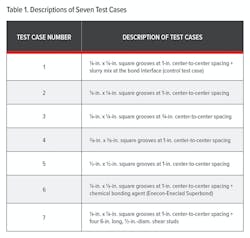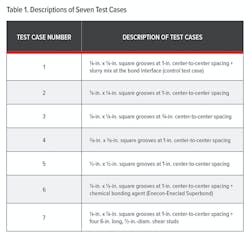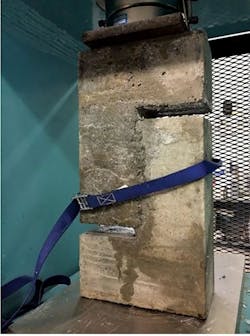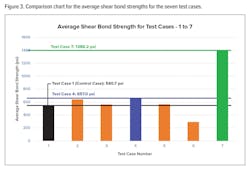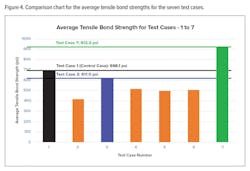Evaluating best practices for placing concrete overlays on prestressed slab bridges
A crucial component of concrete overlays is the bond that exists between the underlying slab and the overlay.
For the concrete overlay to perform as intended, the overlay and the deck slab on which it is placed should behave as a monolithic structure. Therefore, the durability of the entire composite system is dependent on the durability of the bond.
The bond strength of the interface between the overlay and the bridge deck is an important consideration for adequacy of these overlays. Due to traffic loading, the interface is subjected to shear and tensile stresses. It is imperative that the bond strength should be adequate to ensure that the desired service lives for both the overlay and the bridge deck are achieved.
Several factors affect the bond strength, including the material properties of the fresh and hardened concrete, environmental conditions, surface preparation and properties such as cleanliness and roughness, bonding agents at the interface, and mechanical crossing devices across the interface. Of all the factors that influence bond strength, surface preparation and cleaning of the substrate concrete are the most important.
Currently, state DOTs use various methods to provide good bond characteristics between the concrete overlay and the bridge decks. The methods involve the use of bonding agents such as portland cement grout, latex-modified cement grout, cement slurry, chemical bonding agents and mechanical devices such as shear studs that are embedded in either the overlay or underlay to go through the interface.
The issue
In the last few years, solid prestressed span planks (3 ft to 4 ft wide, pulled together by transverse tensioning rods) have been used by the Maryland DOT SHA Office of Structures for small structures over water with spans up to 55 ft for a single span and multiple 55-ft elements for longer bridges. These are then overlaid with a reinforced concrete deck approximately 5-8 in. thick to provide a good riding surface and to protect the longitudinal plank joints from moisture. When built well, this combination of solid planks with concrete overlay has created the nearest structure possible to a maintenance-free bridge. The concrete overlay on the prestressed concrete slab bridges is a crucial component: It provides a safe, stable surface for vehicles to transverse the bridge and serves to distribute the loading to multiple prestressed concrete planks.
Before the overlay is placed, in order to get good adhesion of the overlay to the planks, the contractor is required to place a layer of cement slurry worked into the tops of the planks to aid in the development of a good bond. Prior to placing the slurry, the contractor must construct the rebar mat on the deck (cut to fit and tied together). Then prior to placing the overlay, the contractor must completely remove the rebar mat, thoroughly clean the deck, apply the slurry by scrubbing, and then while the slurry is still in a non-set condition, replace the rebar mat and pour the overlay. The use of cement slurry poses a significant challenge during construction as its application is tedious and time-sensitive, especially on long multi-span bridges, as the overlay slab should be cast before the slurry dries.
This research aimed to investigate other possible procedures that can eliminate the use of slurry as a bonding agent and allow for seamless pouring of concrete overlays in future projects. In order to achieve this, various surface roughness configurations and bonding agents were investigated. A survey also was sent to all state DOTs to sample current practices used to provide good bonding for concrete overlays.
Figure 2. A composite specimen placed for the Double-L test.
Methodology
In this study, two test setups, Double-L and Split-Prism, were used to investigate the shear and tensile bond strength of the interface, respectively. Each specimen was cast from two identical halves to simulate the action of the underlying slab and the concrete overlay. The preparation of concrete specimens required fabrication of custom formwork and multiple wood strips hammered on the bond interface panel of the underlay formwork.
The thickness and spacing of the strips were adjusted for different test cases to provide for the corresponding groove configurations along the bond surface. Nominal reinforcement was provided in the Double-L specimens to avoid any premature concrete failure before the shear bond breaks. The underlying slab was cast using Type III cement and steam-cured according to the specifications used for precast slabs. The overlay was cast using Type I cement and moist-cured at room temperature. For each test, the underlay half is first cast and steam-cured for 18 hours at 140°F. Figure 1 shows an underlay sample after it has been steam-cured and demolded. The sample was then left to cool down for about an hour, after which the overlay was cast over it. The composite was then cured for 28 days at room temperature and tested. For both test setups, seven different test cases with different bond interface conditions were designed, and a comparative analysis was made for the bond strength results obtained. The test case with application of the slurry mix intends to simulate the current practice of MDOT SHA, and serves as the control test case in this study. Table 1 provides descriptions of the seven test cases.
The Double-L test was performed in a standard compression testing machine with attempts made to ensure zero or minimal eccentricity of applied load (Figure 2). This helps ensure that pure shear failure occurs along the bond interface. Similar attempts were made for the split-prism specimens while using the Split-Prism test setup that captures the splitting tensile strength of the bond interface.
For both test setups, three specimens were tested for each of the seven test cases, and the results averaged.
Results and discussions
The average shear bond and tensile bond strengths for the seven test cases are shown in Figures 3 and 4.
It is observed that the control test case (No. 1) involving application of the cement-sand slurry mix has a lower average shear bond strength value than the four test cases that simply have square grooves along the interface and the test case involving application of shear studs across the interface (Figure 3). The grooves provide a better interlocking effect and thus improve shear strength along the bond interface.
For the tensile bond strength tests, the values for test cases that simply have grooves are found to be lower than the control test case (Figure 4). However, the tensile strength values for test cases 2 through 5 (only square grooves along the bond interface) are still higher than the values recommended by the Virginia DOT (233 psi), Oklahoma and New Mexico DOTs (250 psi), and Oregon DOT (175 psi). It is to be noted that in this study, splitting tensile strength values from the Split-Prism tests are reported as tensile bond strength values for the seven test cases while the above recommended values from different state DOTs are direct tensile strength values.
Researchers recently conducted laboratory tests to study the correlation between tensile strength values obtained using Split Cylinder tests and a Double Punch test (pull-off test). The average tensile strengths for rubberized asphalt concrete mixtures recorded using Split Cylinder tests are around 15% higher than the strength values obtained using the Double Punch test. In this study, the average splitting tensile strength values for test cases that only have square grooves along the bond interface are much higher values (more than 15%) than the direct tensile strength values recommended by different state DOTs indicated above.
Positive result
The results obtained from this research study are very positive concerning the use of precast, prestressed slabs that have preexisting grooves or roughened surfaces manufactured at plants to improve the interlocking effect with the overlay. Currently, MDOT SHA uses a cement-sand slurry mix when placing cast-in-place reinforced overlays over prestressed slab decks for small bridges up to 55-ft span or multiple 55-ft elements for long bridges. This process is tedious, cumbersome and inefficient in its current form. In this study, the average shear bond strength values for test cases that simply have grooves running along the interface are found to be higher than the control test case owing to an improved interlocking effect. Moreover, the tensile bond strength values also satisfy the requirements laid out by some state DOTs for bonded overlays.
Based on the results of this study, a slurry may not be necessary to ensure a good bond for the MDOT SHA case that was investigated, provided the surface of the precast slabs are roughened with grooves or similar surface roughening techniques to ensure good interlocking of the bond interface. Shear studs add significantly to the bond strength but may be difficult to implement and may pose logistical challenges while transporting the slabs. The use of bonding agents at the interface warrants further research before arriving at any meaningful conclusions.
